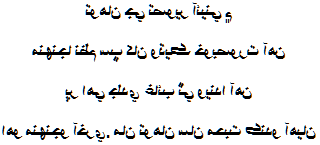Sindhi love poem
آرسي
توهان جي تصوير آئيني ۾
منهنجا نظم سڀ کان وڌيڪ خوبصورت آهن
پر اهي جلدي غائب ٿي ويندا آهن
اهو منهنجو آخري. مان توهان سان محبت ڪندو آهيان

Conversion in Khojki script
𑈀𑈀𑈦𑈵𑈩𑈰
𑈙𑈨𑈭𑈪𑈞𑈵 𑈐𑈭 𑈙𑈵𑈩𑈲𑈥𑈵𑈦𑈵 𑈀𑈀𑈄𑈞𑈰 𑈤𑈰𑈞𑈵
𑈤𑈯𑈞𑈵𑈪𑈵𑈞𑈵𑈐𑈀 𑈞𑈩𑈶𑈤𑈵 𑈩𑈣 𑈉𑈀𑈞 𑈨𑈵𑈝𑈰𑈈 𑈉𑈲𑈆𑈡𑈵𑈩𑈲𑈆𑈦𑈵𑈙𑈵 𑈀𑈀𑈪𑈵𑈞𑈵
𑈟𑈦𑈯 𑈂𑈪𑈵𑈥𑈵 𑈐𑈵𑈧𑈵𑈛𑈰 𑈌𑈀𑈀𑈡𑈵 𑈚𑈭 𑈨𑈰𑈄𑈞𑈵𑈛𑈀 𑈀𑈀𑈪𑈵𑈞𑈵
𑈂𑈪𑈵𑈨𑈵 𑈤𑈯𑈞𑈵𑈪𑈵𑈞𑈵𑈐𑈲 𑈀𑈀𑈉𑈵𑈦𑈰𑈸 𑈤𑈀𑈞𑈭 𑈙𑈨𑈭𑈪𑈞𑈵 𑈩𑈀𑈞𑈯 𑈤𑈯𑈪𑈵𑈡𑈵𑈙𑈵 𑈈𑈞𑈵𑈛𑈲 𑈀𑈀𑈪𑈵𑈥𑈞𑈵
Conversion in Khudawadi script
𑊱𑋙𑋪𑋝𑋥
𑋍𑋛𑋡𑋞𑋌𑋪 𑋂𑋡 𑋍𑋪𑋝𑋧𑋘𑋪𑋙𑋪 𑊱𑊶𑋌𑋥 𑋗𑋥𑋌𑋪
𑋗𑋣𑋌𑋪𑋞𑋪𑋅𑋠 𑋌𑋂𑋩𑋗𑋪 𑋝𑋖 𑊻𑋠𑋌 𑋛𑋪𑋐𑋥𑊺 𑊻𑋤𑋔𑋪𑋝𑋤𑋙𑋪𑋍𑋪 𑊱𑋞𑋪𑋌𑋪
𑋒𑋙𑋣 𑊲𑋞𑋪𑋘𑋪 𑋂𑋪𑋚𑋪𑋏𑋥 𑊾𑋠𑊰𑋔𑋪 𑋎𑋡 𑋛𑋢𑋟𑋏𑋠 𑊱𑋞𑋪𑋌𑋪
𑊲𑋞𑋪𑋛𑋪 𑋗𑋣𑋌𑋪𑋞𑋪𑋅𑋧 𑊱𑊻𑋪𑋙𑋥। 𑋗𑋠𑋌𑋡 𑋍𑋛𑋡𑋞𑋌𑋪 𑋝𑋠𑋌𑋣 𑋗𑋣𑋞𑋪𑋔𑋪𑋍𑋪 𑊺𑋟𑋏𑋧 𑊱𑋞𑋪𑋘𑋌𑋪
Romanization
Aarse
Tawhan je taswira aaine men.
Muhinjaa nazam sabhu khan wadheeka khubsurat ahin.
Para uhe jalde gaib thi windaa ahin.
Uho muhinjo aakhiri. maan tawhan saan muhabat kando aahiyan.

→ French poem ←
Woman from Sindh & Sindhi
Sindhi love poem (پيار نظم), an Indo-Aryan language of the sindh region, here in Arabic alphabet. This official language of India and Pakistan is understood by 20 million speakers. Will she hear me? Indeed i am far away! Yes she will hear me, in reading in sindhi my very short poem. We'll see, in which language she will answer me!
The sindhi (other possibilities : Sindi, Lari, Bhatia, Central Sindhi, Vicholi, Sindhi Musalmani, Kayasthi, Hindu Sindhi, Macharia, Thareli, Vicholo, Katiawari Kachi, Viccholi, Lasi, Shikari Bhil, Thari, Muslim Sindhi, Visholi, Dukslinu, Jadeji, Kachchi, Autonym : سنڌي , सिन्धी ), which is close to the lahnda, has very ancient origins.
Its main phonological feature is the abundant use of implosives. There are many Arabic and Persian borrowings. It can be written as here with the Arab-Persian characters, or the devanagari, or also with an original writing (Hindus). The main dialects are vicholi (closest to the standard language), siraiki, and kacchi, which is influenced by Gujarati. Sindhi finds its roots in the lower Indus Valley.
Its name comes from the name of this valley (Sindhu). Half of the Sindhi speakers live in rural areas, the others, in the cities, also speak English and Urdu. The history of Sindh is the history of the ancient Harappan civilization, a culture that we still find in the actual folklore and religious rites. There is probably a link between Sindhi and harappan language, but we really dont know because the harappan script is still not decrypted. It is thought that it would have a Dravidian origin, linked to the presence of Brahui and neighboring dravidian languages of the past.
During its history Sindhi has been confronted with many influences, for example the English which it will borrow. Since the 6th century, will succeed: Achaemenid, Greek, Mauryan, Scythian and Persian, and Alexander the Great (-329 -324). Then after a quieter period, it will be the Arab invasions (+711). From this last period, date, the influence and an important loan to Persian. The dynasties will succeed, until the arrival of the English in 1843. These loans from such diverse languages, wil give some complicated forms, for example many different verbal inflections.
The first reference to Sindh, dates from the Natyasastra, a dramaturgy written in the beginning of our era. The first text showing the written language, is a translation of Koran in 883, followed a hundred years later, in Persian, by the translations of the Mahabharata, since old Sindhi.The ancient literature is made of ballads, taken again in the 18th century. By Abdul Latif Bhitai. The novel is represented by Mirza Kalich Beg, and mystical poetry by Abdul Wahhab Sachal Sarmast.